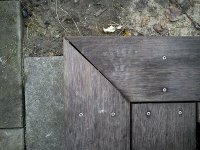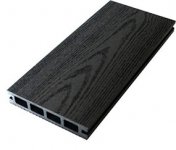Kristian
Member
- Joined
- Mar 26, 2007
- Messages
- 205
This summer I finished a deck using hardwood (smooth on one side / grooves on the other) and the miters were tight. Now one of the miters have opened up and I'll fix this eventually but I'm looking for suggestions as to how I could have prevented this? It's my first deck using hardwood so besides the obvious option of placing screws closer to the outside corner would gluing the miter have helped? I'm under the impression that not all hardwood accepts glue equally well or is that wrong?
The wood had been stored outside for close to a month so I would assume that it had absorbed all the moisture it could, although the wood has been exposed to a lot more rain after the project was finished.
Thanks for your input.
- Kristian
[attachimg=1]
[attachimg=2]
The wood had been stored outside for close to a month so I would assume that it had absorbed all the moisture it could, although the wood has been exposed to a lot more rain after the project was finished.
Thanks for your input.
- Kristian
[attachimg=1]
[attachimg=2]



